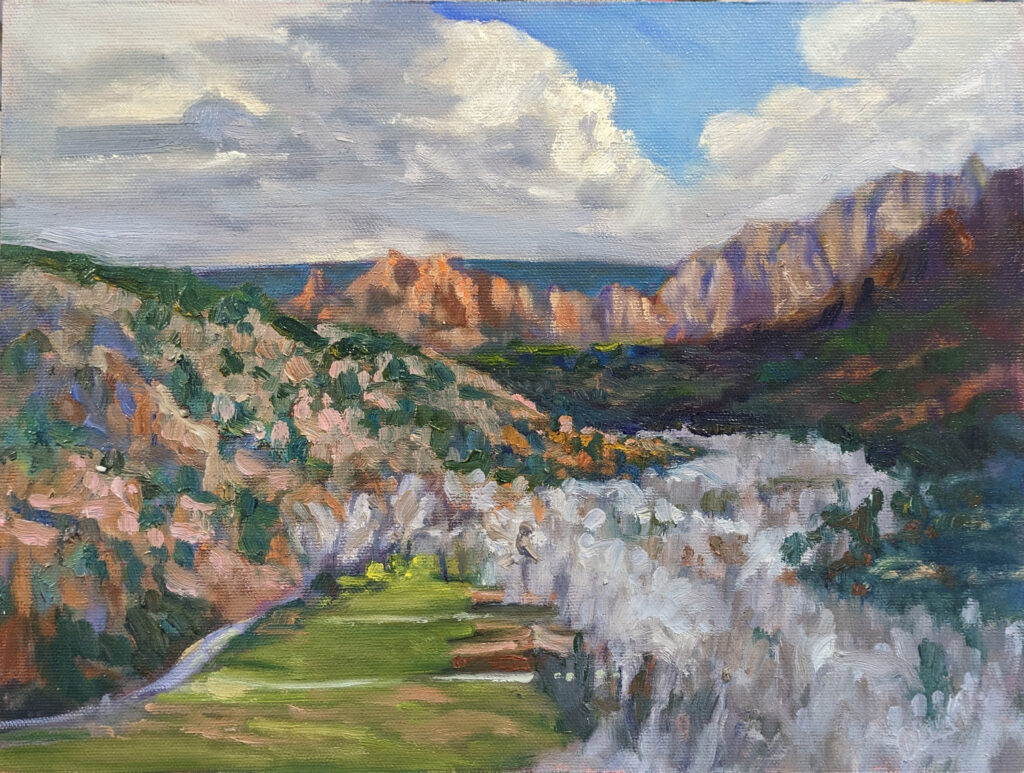
Last month I wrote that I was too idiosyncratic to be a forger. It requires sublimating your own creativity to another’s vision. What’s the fun in that? You might as well be an engineer; it pays better.
US copyright law says you can’t copy someone else’s work, except under limited circumstances. One of these is ‘transformative use,’ which has a bit of an “I’ll know it when I see it” definition.

Transformative use could mean:
- Parody: Creating a work that imitates or mocks the style or content of the original copyrighted material for humorous or satirical effect.
- Commentary or criticism: Using copyrighted material as a basis for commentary, critique, or analysis, where the new work adds new insights or perspectives.
- Educational or informational purposes: Incorporating copyrighted material into educational or informational content to illustrate a point or convey information.
- Remixes or mashups: Combining multiple copyrighted works to create a new, original work with a different meaning or expression.
That last one is where the visual artist has some latitude. For example, I might want to put an 18′ Grumman aluminum canoe in a painting and am too lazy to walk out to the back yard and photograph my own. If it’s a detail in an otherwise completely different work, I can reference someone else’s photograph. I cannot, however, copy Dorothea Lange’s dustbowl photographs verbatim and expect to get away with it. Of course, there’s a lot of grey area in between these two examples.
Transformative use is judged on a case-by-case basis, which is why famous artists like Jeff Koons keep stealing from less-well-known ones. They can better afford protracted legal cases.
British artist Damien Hirst also has a long rap sheet when it comes to plagiarism, but he may be the first artist in history to be accused of forging his own work.
Among several examples reported by the Guardian is an $8 million, 13-foot tiger shark split into three sections and suspended in formaldehyde at the Palm Hotel and Resort in Las Vegas. It was dated 1999, but was made in 2017.
The works were first shown at a 2017 Hirst solo show called Visual Candy and Natural History, and dated “from the early to mid-1990s.”
“Formaldehyde works are conceptual artworks and the date Damien Hirst assigns to them is the date of the conception of the work,” Hirst’s company said.
The artist’s lawyers added that “the dating of artworks, and particularly conceptual artworks, is not controlled by any industry standard. Artists are perfectly entitled to be (and often are) inconsistent in their dating of works.”
A more prosaic explanation is that Hirst’s reputation is in decline. More recent works do not sell at the prices he commanded when he was one of the fresh new Bad Boys of British Art. By backdating his catalog, he could hope to make more money.
Formaldehyde slows down but doesn’t stop decay. Some of Hirst’s earlier pieces are rotting, or the original specimens have been replaced. What a revolting job for the conservators, not to mention the gallery assistants who did the work in the first place. Formaldehyde is a highly toxic systemic poison that is a severe respiratory and skin irritant and can cause burns, dizziness or suffocation. If you’re inclined to deface artwork for political or environmental reasons, Hirst’s suspended animals seem a far better target than an irreplaceable oil painting.
My 2024 workshops:
- Sea & Sky at Schoodic, August 4-9, 2024.
- Find your authentic voice in plein air: Berkshires, August 12-16, 2024.
- Art and Adventure at Sea: Paint Aboard Schooner American Eagle, September 15-19, 2024.
- Immersive In-Person Workshop: Rockport, ME, October 7-11, 2024.




I have a photograph in my gallery that is a close copy of a silk screen print “Kodachrome” by Ann Laden:
https://photos.randrews4.com/RAndrews-Photos/All-of-the-Top-Rated-Photos/i-ZVbfrV3/buy
I started with an original photograph and changed the colors to match Laden’s print. I changed the wording to update the current status of Kodachrome. Would this be considered plagiarism? It probably doesn’t matter that I credited Laden in my description. Does it matter that I have yet to sell a copy?
Ron, I asked an intellectual property lawyer. Here’s his answer:
The question is whether your use of what I assume is a copyrighted work is deemed to be “fair use.” There are 4 factors that are examined to determine whether something is deemed to be fair use of a copyrighted work:
The purpose and character of your use
The nature of the copyrighted work
The amount and substantiality of the portion taken, and
The effect of the use upon the potential market.
For #1 The question here is whether you’re creating it for commercial purposes; commercial applications are given the least amount of protection. You’ve added words to it so you could claim that it’s a social statement about industrial progress. Your position would be that your use created new meaning for the work. (See brief discussion below on transformative use.)
For #2 the nature of the works are similar in that one is a photograph and the other is a copy of the photograph.
For #3 you’ve taken the entire work.
For #4 I’m not sure your use of the work will have much impact on the market of the original though I’m not sure there’s much of a market for that, but I don’t know how it was used, whether it was mass produced in posters, etc.
Whether a use is transformative is a subset of the fair use doctrine. Cases are all over the place on this issue. For example, Marcel Duchamp’s marked-up Mona Lisa was deemed to be transformative.
Of course, he didn’t have to fight da Vinci over the copyright; he just had to establish that he took a work in the public domain and transformed it: quite a different challenge. Cases addressing whether a use is transformative are somewhat fickle so it is difficult to predict a result, but, in a stroke of luck for you, the US Supreme Court last year addressed a quite factually similar question involving an Andy Warhol silk screen of a copyrighted photograph. A crude reduction of the court’s decision is that if you merely copy and colorize a copyrighted photo, it’s not transformative, but if you do something more (such as Warhol’s soup can art) it might be considered transformative. You’ve added words and are making a statement, so you could argue that it’s transformative. Here’s a short article about the decision: https://frostbrowntodd.com/supreme-court-clarifies-transformative-art-in-the-context-of-copyright-fair-use/
The thing to remember about fair use, though, is it’s a shield, not a sword. The only time you need to raise it is if you’re being attacked. While you might prevail, the question is whether you have to endure a costly fight to do so.
Yes, you violate a copyright even if you have not sold a copy. Creating it is the violation; publishing it/broadcasting it magnifies the violation and the risk of being caught. Giving the original artist credit does nothing other than make it easier for the artist to find the altered work and establish that you used her work. It provides no defense.
(Mark Costello, Boylan Code LLP, Rochester, NY)
I think you probably could be sued for that. I know I wouldn’t allow it on the FB sites I help manage for copyright violation. No attorney here, just have been wading in those murky waters for years now. many artists, especially those early in their learning trajectory, seem to think that if you change one little thing that they can copy anything they want, and the reality is that just is not correct. and Barron mind, we live in a litigious society, where anyone can sue anyone about anything. Whether they will win or not is another story, but do you really want to put yourself through that? And the final answer I ask people who are copying others Work is… Why? Why, when you have your own voice and presumably your own things to say, do you feel the need to study, copy, market, and sell something that did not originate within your own fabulous brain?
Formaldehyde was identified as a probable carcinogen in 1987. That didn’t help my friend and colleague, Tom St. John who ran a film processing machine for 30 years that had formaldehyde in an open tank. He retired in 1982 and died of cancer in 1984.
Oh, Ron, I am so very sorry.
I love reading your thoughtful and insightful posts. I am seeing a lot of “transformative” art these days, particularly when it relates to Pop art.
Watch, “The Price of Everything,” on Prime and other streaming sources. It’s all about the NY (and global) contemporary art feeding frenzy–collectors, galleries, auction houses AND artists. Fascinating, depressing, engaging, annoying, touching, angering… It’s enough to make one invest in Bitcoin!
Mark
https://www.imdb.com/title/tt7475540/